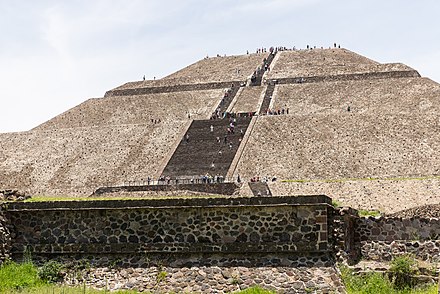Archaeological sites
Archaeological sites
An archaeological site (or archeological site) is any place with physical evidence of past human activity. Such sites might be from pre-history as well as history, and the oldest sites can be considered paleontology. Even remnants from modern times can count as archaeological sites.
Some archaeological sites give opportunities for tourists to take part in excavations. Other sites have developed into tourist traps, where commerce is dominant above the genuine experience.
For places that are both archaeological sites and still inhabited, there is a separate list at Old towns.
Ghost towns are abandoned settlements large and intact enough to look like towns. They were usually deserted no more than a few centuries ago - often within living memory.
Understand
 There is no commonly accepted age limit for when a remnant of human activity becomes an archaeological site. Also, it is very difficult to define its geographic borders. New sites are fairly often discovered during modern excavations with some other purpose; China's Terracotta Warriors were found by farmers, and people building roads or digging foundation have turned up others. In some countries any major construction project and even fairly minor ones in historic Old Towns is planned with time allocated for archeological exploration from the get-go.
There is no commonly accepted age limit for when a remnant of human activity becomes an archaeological site. Also, it is very difficult to define its geographic borders. New sites are fairly often discovered during modern excavations with some other purpose; China's Terracotta Warriors were found by farmers, and people building roads or digging foundation have turned up others. In some countries any major construction project and even fairly minor ones in historic Old Towns is planned with time allocated for archeological exploration from the get-go.
Most countries have some legal protection of archaeological sites. Legal consequences for trespassing in closed areas, damaging remnants, or removing artifacts, are often harsh. In particular, countries with a colonial history may resent loss of relics to places like the British Museum, and may therefore be inclined not to be at all gentle with modern relic exporters.
With or without laws, the leave-no-trace principle is recommended for these places.
Buy
See also: Art and antiques shopping
There are several kinds of archaeological souvenirs: Permits required
There are export restrictions or total prohibition against the export of archaeological and other cultural artifacts in many countries. Penalties can be anything from just seizure of the article to long prison sentences, though hefty fines are the most common punishment.
Even in countries that allow export of artifacts, permits are generally required; there will be paperwork and fees. Depending on the country, getting the permits may be anywhere from a minor hassle to very expensive and time-consuming, if it is possible at all.
- Genuine artifacts: Possession or export of these is legally restricted in many countries. Trying to collect some at an archaeological site is illegal in most countries since it destroys valuable historical information. Trying to buy them from most vendors is far more likely to get you a forgery than a real item.
If you really want a genuine artifact, be prepared to deal with a reputable vendor, to pay a stiff price, and to get the necessary permits. One way to recognize good vendors in the country of origin is that they are prepared to help with the permit process and the information they give you on that agrees with what you find from government sources. Outside the country, the best sources are usually the major international auction houses; be prepared to pay a premium price since you will be bidding against museums and collectors.
- Forged artifacts: These are claimed to be genuine, so they might cost as much and cause as much legal trouble as a genuine artifact. They are worth neither the price nor the trouble.
- Cheap imitations: Often available from vendors near the sites or in tourist shops nearby. These can be a good buy, but you will often have to bargain hard to get a reasonable price. Quality ranges from absolute junk to excellent.
- Official replicas: These are generally sold by museums, copies of items in their collection. They are probably the safest choice for a traveller, usually good quality and sold at fixed prices. Not all are sold at the sites themselves; the country's national museum or a museum in a nearby city may offer replicas, and major museums like the Smithsonian or the British Museum have fine replicas based on finds from all over the world.
Nearly all travellers should restrict themselves to the last two categories.
Work
Archaeology involves a great deal of work and helping out on a site might be both fascinating to a participant and valuable to a project. Unfortunately the field is generally not well funded and most projects cannot afford to pay anyone except professionals and perhaps some graduate students or, in some places, cheap local labor.
 There are programs in various countries that involve volunteer work on archaeological digs:
There are programs in various countries that involve volunteer work on archaeological digs:
Sometimes even local groups have volunteer opportunities. For example in the Ottawa area, the NCC (National Capital Commission) runs an annual archaeology month, usually in August.
See also:
-
World Heritage Volunteers. A UNESCO program mainly working on preservation of UNESCO World Heritage Sites
-
Past Horizons. An index of archaeological projects worldwide that need volunteers
Famous archaeological sites
Europe
See also: Prehistoric Europe
- Alpine countries: Prehistoric Pile Dwellings around the Alps
- France: Nîmes, Le Pont du Gard
- Greece: Athens/Acropolis, Delos, Delphi, Kos, Knossos, Mycenae, Olympia, Rhodes, Samos, Samothrace, Philippi
- Italy: Capri, Cerveteri, Gela, Herculaneum, Ostia, Paestum, Pompeii, Rome/Colosseo, Syracuse
- United Kingdom: Stonehenge
Africa

- Egypt: Abydos, Abu Simbel, Amarna, Dendera, Edfu, Karnak, Kom Ombo, Giza, Saqqara, Philae, Valley of the Kings
- Libya: Leptis Magna
- Morocco: Volubilis
- Tunisia: Carthage, Dougga, El Jem, Kerkouane, Sufetula
- Zimbabwe: Great Zimbabwe
Asia
 See also: Ancient Mesopotamia
See also: Ancient Mesopotamia
- Cambodia: Angkor Wat
- China: caves outside Dunhuang, Anyang, Great Wall of China, Xian, Luoyang, Beijing
- India: Fatehpur Sikri, Hampi, Nalanda, Pataliputra
- Indonesia: Borobudur, Prambanan
- Iraq: Babylon
- Israel: Akko, Beer Sheva, Caesarea, Gezer, Hazor, Masada, Megiddo

- Jordan: Petra
- Myanmar: Bagan, Mrauk U
- Pakistan: Harappa, Mohenjo-daro, Taxila
- Palestinian Territories: Jericho
- Saudi Arabia: Madain Saleh
- Thailand: Ayutthaya, Sukhothai
- Turkey: Aizanoi (Çavdarhisar), Aphrodisias, Assos, Çatalhöyük, Ephesus, Halicarnassus (Bodrum), Göbekli Tepe, Hattusa (Boğazkale), Kaunos (Dalyan), Miletus, Patara, Pergamon (Bergama), Sardis, Troy
- Turkmenistan, Gonur Depe
- Vietnam: My Son
- Denisova Cave, 51.3975°, 84.676111°. Site where an extinct human species related to Neanderthals were first discovered. Remains are about 40,000 years old and the Denisovans seem to have ranged across much of Asia. Some modern humans, especially Melanesian, have some Denisovan DNA.
See also Sacred sites of the Indian sub-continent, Indus Valley Civilisation, Chinese Empire, Persian Empire, Mongol Empire, Khmer Empire, Pre-modern Korea and Pre-modern Japan.
Americas
See also: Indigenous cultures of North America

- Belize: Xunantunich
- Bolivia: Isla del Sol, Tiwanaku
- Brazil: Serra da Capivara National Park
- Canada: Viking settlement at L'Anse aux Meadows, Red Bay Whaling Station (Newfoundland)
- Colombia: Ciudad Perdida de Teyuna
- Guatemala: Tikal, Piedras Negras, El Mirador
- Honduras: Copan Ruinas
- Mexico: Chichen Itza, Cacaxtla, Coba, El Tajin, Ek Balam, Templo Mayor, Plaza de Tres Culturas (Tlatelolco), Monte Alban, Palenque, Paquime, Teotihuacan, Tula, Tulum, Uxmal, Xcaret, Bonampak
- Nicaragua: ruins of old León, Huellas de Acahualinca (pre-historic footprints in Managua)
- Peru: Choquequirao, Machu Picchu, Nazca, Ollantaytambo, Pisac
- United States: Cahokia Mounds State Historic Site, La Brea Tar Pits at Hancock Park inside Los Angeles, Moundsville, Ohio prehistoric sites, Taos Pueblos.
Oceania
- Australia: Brewarrina Aboriginal Fish Traps, Gunbalanya, Lake Mungo, Murujuga
- Tonga: Lapita Pottery Archaeological Sites See also: Indigenous Australian culture